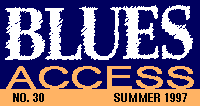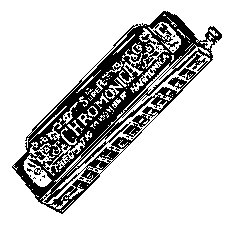

 | ||
| The Doctor is In! |

Morning has broken. Save the pieces, though. I think I can glue it. One look at the good Doc in the a.m., and it takes no mental calisthenics to understand how his mug would put the hurt on Mighty Mouse. His mug, at present, holds a vapor-rich draught of Cafe Bayonne, infused with the essential oil of Valvoline, and darned if his heart valves aren't knocking less, except on the hills. He swoons with the Zen-like perfection of the eternal now, he strains the java like brine shrimp through the baleen of his mustache, he notices writing on the high rag content paper (matches his wardrobe, he muses) and, stumbling headlong through the doors of perception, he reads, as if for the first time, the letter he now holds in his hand. He butters his French cuff and gnaws it distractedly.
Dear Harpo,
What do you think of Hohner's MS harp series with changeable reed plates? I have three Big River harps, keys of C, G and E. I got a free copy of BLUES ACCESS from the Red Rooster radio show.
David B. Strayer
Davenport, Iowa
Removing a cuff link from his buccal recesses, the Fountain of Irrelevancies jots a note in naval jelly on a toast point. Regard.
Dear David,
I like Big River Harps for a number of reasons. First, they're cheap, like me. Cheaper, anyway, by at least three bucks, relative to the usual assortment of Hohner Diatonics. They play well right out of the box, with no break-in period, especially on the high notes, making blow bends possible immediately after you claw your way through that plastic cocoon they're packaged in. (Locks in freshness, though.) I suspect that you never get a dud with these since there are no wooden combs to get cranky and swell up. They also have a good tone -- especially for a plastic-bodied harp.
Are there some negatives? Not big ones. The slightly fatter dimension of the body, top-to-bottom, might feel to some players like they're trying to play a Subway sandwich. I personally prefer the tone and "snap" of Marine Bands on staccato notes, which I haven't found on plastic harps, including this one.
As to the reed plates, it's cheaper to replace the plates than it is to replace the whole harp, and this is a well-designed system. I would suggest that you also get an "A" and "D" harp, as these are the most common keys used on recordings. It's easier than changing reed plates for every song.
Now, isn't it time you started paying for those magazines?
Dear Harpo,
I'm a classical trumpet soloist by profession, but have been playing harp for several years now. Does anyone know, preferably from Paul Butterfield's own mouth, how he gets that throaty vibrato? I get pretty close by rapidly closing my throat while pumping into my belly, but it's never quite there. Mickey Raphael (with Willie Nelson) has it almost exactly. Michael Bloomfield told me years ago that Butter was "coughing backwards." Thanks a lot.
Stuart Laughton
Burlington, Ontario, Canada
Recovering from an attack of coughing through his ears, the dubious Doc studies his manly reflection in the back of a teaspoon as he touches up his pompadour with a fork. Resigning himself to being primarily a love object, he whistles in a minor key through his nose. A cab appears and all involved regard each other quizzically.
Dear Stuart,
That's really a two-part question about Butterfield. For vibrato on the out-breath, you already have the technique that you need from the diaphragmatic muscle development and control that you use playing trumpet. This is similar to the vibrato that singers (most of whom breathe out when singing) use to vary the intensity of the sound that they put out. They simply vary the amount of air that they force out of their lungs through a motion similar to a belly laugh. This is tough to master but works well for harp, trumpet or voice.
That's not what you need, though. Harp players like to draw in on notes so that they can bend them by deflecting the direction of the flow of air through the reeds. If you listen closely to Butterfield, he uses a different type of effect on out-breaths, a true vibrato, involving a change in volume of a sustained note. On the in-breath he is actually changing the tone of a note, which is a tremolo effect (like a whammy bar on a guitar). By a series of rapid-fire bends accomplished primarily by the tongue in the same way that you bend a single note, he produced the fat sound you want to duplicate. It also is the position that maximizes the fullness or bassiness of the tone you produce. This, coupled with Butterfield's use of a very tight grip around a good quality vocal mike, gave a very bassy sound to that in-breath tremolo.
So, how to do it? Simple, if you can bend a note. Draw in on the #2 hole, bend it slightly and move your tongue and jaw as if you're saying "yo-yo-yo" repeatedly, throughout the bend. That's it! Easy for me to say, hard to do unless you fool around with it for awhile. For a lighter bend, try saying "ya-ya-ya" instead. It'll seem easy, once you master it.
Dear Harpo,
I have only two very simple questions for you. First, I'd like to play blues with those minor, low and high-tuned harmonicas, but I don't know which keys to buy, or should I continue with the major tuned? Second, would you give me more details about the "Magic Harps" (developed by Magic Dick) and how can I get them. Please, you need to help me, I can't do it by myself.
Luis Fernando Lisboa
Presedente, Prudente, Brasil
Harpo leans back and picks his teeth with the air of one who knows. He inserts the teeth he picked, puts down the glass they were in, rinses with Efferdent and fans the air around one who knows. Hopefully now he knows the noxious consequences of Cafe Bayonne and naval jelly. Anyhow ...
Dear Luis,
Simple, yes. Brief, no. First, minor harps called "natural minor" produce a chord on both the in-breath and the out-breath in a minor key, and are set up to be played in cross-harp position. I'd start with an "A" natural minor, as it's a common key. All of the draw notes are set up to work within a minor scale and allow bends on all of the familiar holes that you use for typical cross-harp. In short, the whole harp is useful for minor tunes, not just 4, 5, 6 and 7 holes, like in 3rd position, and you can do chords and trills easily, also not possible with 3rd position.
Low tuned harps, like a low "F," allow for easier playing than the original pitched an octave higher, especially in 1st position. Those high blow bends are possible on the low-pitched version, but low bends get tougher every key you descend. So, if you struggle with cross-harp bends in "G," you'll asphyxiate trying to bend a #2 draw on a low "9." Conversely, if you want an easier harp than a normal "G" for lower bends, try a high-tuned "G." Forget the Jimmy Reed stuff on that little shrieker, though.
I am sworn to secrecy on the entire matter of Magic Harps, as I promised Magic Dick I wouldn't divulge any details prematurely. I can say that I've heard both the harps and the theory behind them, and get set for a revolution in harpdom, come this fall. Negotiations with Hohner are finalizing, a 20-year project will be revealed in about 6 months, and I guarantee you will be astounded. And, yes, they will be widely available, and they will change your playing. Am I excited? Well, this is my third set of dress shields today.
The pataphysician of the musical mouth organ puts down his pen and opens the door to his home gym. A can of long-ago congealed house paint falls off the top shelf and conks him on the noggin, dislodging a carefully taped-on propeller blade. Pushing aside various articles of indeterminate usefulness, he settles in at his multi-function Lips-Ercizer, recently purchased from QVC for $39.95. Thinking about what a good example he's setting for his patient readers, he goes back to sleep.
Got a June bug in your boxers about matters harpish? Send a letter to Dr. Harpo and receive a small nugget of truth wrapped in a carpet of irrelevancy. And you only have yourself to blame.
 |
 |